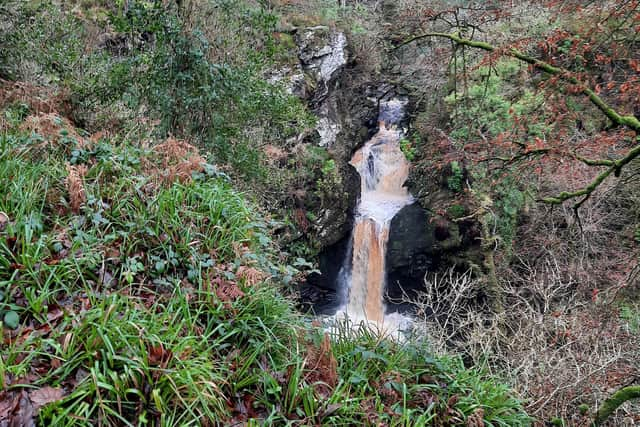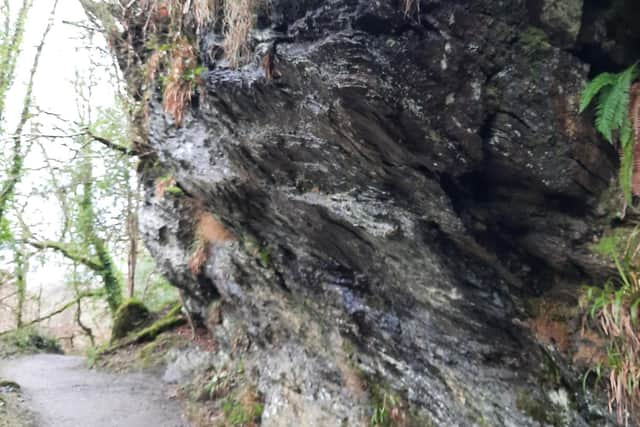On the trail of Shane Crosach in the ancient Ness landscape
and live on Freeview channel 276
Road works on the route from Derry to Belfast are in full swing. Getting to the park involves extra traffic lights, unaccustomed bends and diversions along narrow country lanes.
I was not annoyed at the inevitable upheaval but by the thought that this project should have been completed fifty years ago. We, my two grandsons and friend Padraig O’Brien, began our walk at the visitors centre, temporarily closed due to the pandemic.
Advertisement
Hide AdAdvertisement
Hide AdWe set off in the direction of the waterfall which gives the park its name. ‘An eas’ is the Irish for waterfall, hence Loch Ness, Lake of the Waterfall. The paths in the first part of our walk pass through a valley which slopes gently on both sides. Being midwinter the pond appeared very quiet and lifeless.


In spring it will come alive and be brimming with life: numerous kinds of invertebrates, frogs and even the relatively rare newt. The mizzly weather meant the playground was deserted of any children. We had the place to ourselves. We took time to read one of the information notices.
Would we see red squirrels in the trees, otters and dippers in the river, the boys asked. Unfortunately not but we saw numerous robins and even heard a raucous raven calling in the trees high above us.
The path narrowed passing under overhanging rocks. These are made up of Dalradian shales. At over 400 million years old, they are the oldest rock formations in mainland Ireland. They are only surpassed in age by the 800 million years of the rocks on Inishtrahull Island north of Inishowen. Running through the rocks are narrow faults filled with the white mineral quartz. The faults lead down through the earth’s crust.
Advertisement
Hide AdAdvertisement
Hide AdIn the distant past valuable minerals were forced to the surface along with the quartz. Gold from these veins of quartz was used to produce marvels such as bronze age jewellery and the Ardagh chalice.


There are modern plans to exploit this wealth not far away in Tyrone. It remains to be seen if these riches can be extracted without untold damage to the environment. ‘Where there’s muck there’s brass’ and vice versa.
Emerging from the narrow path, it was obvious we were in a completely different surroundings. The gentle slopes had given way to a steep sided gorge. In just few steps everything had changed, even the weather.
Advertisement
Hide AdAdvertisement
Hide AdWe were in a microclimate, warmer, damper and with much less wind. We were surrounded by a forest of ancient oaks and hazel. Brilliant green moss matted their trunks, lichen hung delicately from their branches. The forest floor was a carpet of ferns. We had taken a step back in time to Ireland 10,000 years ago when the Irish landscape was covered in similar forests.
We were now aware of the roar of the waterfall. The boys counted 100 steps as we made our way above the main waterfall. Legend has it that it was here that Shane Crosach O’Mullan jumped the river to escape his captors around the year 1700.
Was he one of the super heroes, Batman, Superman or Spiderman, my grandsons never tire of talking about? Apart from being a possible world record long jumper he possessed no superpowers.
He is one of the few people of humble background whose story emerges from the pages of our tragic history. He was born towards the end of the 17th century in Greysteel. His father was a school teacher. He was driven off his lands as a result of a row with the son of the local bailiff. Dispossessed, like many of his religion by the upheaval of the 1690s,
Advertisement
Hide AdAdvertisement
Hide AdShane Crosach was not one of the Wild Geese. They had the funds to escape to a new life on the continent to become part of Europe’s aristocracy. Among them were the Hennessys of brandy fame and Charles De Gaulle’s County Down ancestors, the McCartans.
Shane entered on a career of resistance and banditry on his local turf. His activities stretched from Greysteel to Maghera. His fame was such that Glenshane Pass is supposedly named after him. After many scrapes with the ‘law’, there were no more rivers to be jumped. He was hanged along with his two sons in Derry in 1722.
On the day of our walk in far away Minnesota, Lisa Montgomery was executed by lethal injection. One is left wondering about these events, separated by 300 years, where the real barbarism lies. Moving on from Shane’s leap, we got a good view of the waterfall. Innumerable gallons of water seemed to spurt out of nowhere.
Advertisement
Hide AdAdvertisement
Hide AdIn 2017 the floods devastated many areas in the region: Plumbridge, Eglinton, Burndennet and Burnfoot. Ness woods park did not escape. The paths in the park required extensive repairs. This was nothing to the deluge that formed the Ness waterfall.
My own image of the formations of features like the waterfall and the gorge was of the painfully slow process of water sculpting rocks over millions of years. More modern thinking argues for altogether more dramatic events.
Ireland, like much of the world, had been in the grip of the last ice age lasting 100,000 years. The idea that the ice melted slowly over thousands of years has been replaced by a more dramatic interpretation.
About 13,000 years ago the ice sheets covering Ireland melted over a relatively short period, perhaps as little as 100 years. The ice was by this time a kilometre thick and extended in a huge sheet over much of Ireland.
Advertisement
Hide AdAdvertisement
Hide AdThe rapid melt transformed into an unimaginable volume of water. Carried by this flood were the rocks, gravel and sand that the glaciers had ripped from the landscape. A new river course was formed. When the river hit a particularly hard lump of rock, it undercut the softer material below forming the waterfall. The debris carried by the river acted as a massive file grinding out the gorge as the waterfall retreated.
We made our way back to the car park. On the drive back to Derry I was struck by the thought that the organised chaos of the road building depends on the same forces that formed the waterfall.
The rock, gravel and sand were dumped by the retreating glaciers in the valley of the Faughan River. It is now being quarried to make the concrete and tarmac used to build the new road.
Will anyone think we have the ice age to thank when the new road is eventually completed?